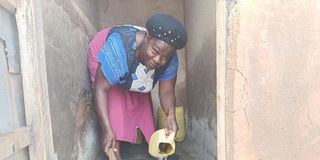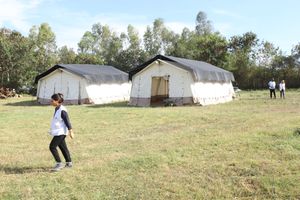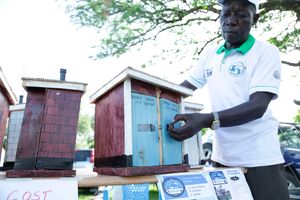Unlocking dignity: Kisumu’s push to end open defaecation through improved latrines

Ms Lilian Akinyi cleans an improved latrine at her compound in Nyalenda slums, Kisumu County.
What you need to know:
- A 2023 report by Unicef and the World Health Organisation revealed that five billion people still live without safely managed sanitation, while another 419 million practise open defaecation.
Ms Irene Akinyi, a mother, would love to raise an independent, courageous woman in her three-year-old daughter, Daisy.
But growing up in the expansive Nyalenda slums exposes the young girl to several hazards. She is supervised in almost every move to avoid accidents. Until recently, one of the hazards had been the pit latrines they used. Daisy risked falling into the large defaecating hole.
But when we arrive at the home, Irene’s face speaks of a relieved mother. She watches her daughter playfully make her way to the ablution block unsupervised. She hands her a key to use to unlock the latrine door. Daisy is also armed with a container filled with water. She enters the latrine and closes the door behind her. A few minutes later, she leaves, having emptied the water container.
She gently closes the latrine door, locks the padlock, before returning the key to her smiling mother, who is busy washing clothes. “Unlike in the past when I had to pause my duties to attend to her whenever she was responding to the call of nature, this is no longer the case,” Irene says.
Until April, Daisy, alongside other children, would attend to the call of nature on a potty. Other caregivers would spread a paper for the minors to relieve themselves, and the faecal matter would be disposed of in the latrine. This was a major challenge, with some women leaving the undisposed faecal matter for hours, thus compromising sanitation in the congested slum.
“Sometimes it would take hours before the faecal matter was disposed of in the latrines, inviting flies buzzing both inside and outside our houses,” Irene says.
Rainy seasons
Her fellow tenants also had only a single pit latrine serving over 25 individuals. Every four months, the latrine would be full and had to be emptied. Whenever the landlord failed to act on time, tenants would ease themselves around the compound. “This can only explain why during rainy seasons, cases of dysentery, diarrhoea and typhoid are always common,” Irene says.
In August, the compound was among the places that benefitted from improved latrines. The pit latrine is now fitted with a Sato pan, which uses a mechanical water seals to close off pit latrines from open air. It has completely done away with the risk of a child accidentally falling in.
The Sato pans have a lid that keeps the shallow pit latrine closed when not in use. The lid, however, opens when any slight weight lands on it and closes afterwards. After using the latrine, one flushes the faecal matter using some water.
Lilian Akinyi, another resident, is also a beneficiary of the improved latrine. The mother of two says one major advantage of the latrine is the fact that it has completely done away with the odour, which gets worse on sunny days. “There have been cases of locals approaching a community health promoter (CHP) to raise concerns about the latrine odours.”
George Odede, a CHP, says diarrhoea and stomach infections among under-fives are common in the area. The rocky grounds and a high water table make it hard to dig a proper pit latrine, he says. In most cases while digging the latrines, one gets to water barely three feet deep, with many opting to stop at that.
The pits not only fill up faster but are always flooded during rainy seasons, thus emptying the faecal matter into nearby water sources. He also raises concerns about landlords who leave the responsibility of digging a pit latrine to tenants, who often resort to open defaecation. “During flash floods, a number of latrines often collapse, contaminating surface water utilised by slum dwellers,” George says.
Marking World Toilet Day on November 19, the United Nations argued that the “safe toilets for all by 2030” sustainable development Goal is seriously off track. Toilets remain an essential space at the centre of human life and should be kept safe and secure. Billions of people are, however, at threat of conflict, climate change, disasters and neglect.
A 2023 report by the United Nations Children’s Fund (Unicef) and the World Health Organisation revealed that five billion people still live without safely managed sanitation, while another 419 million practise open defaecation. The report estimates that 2.2 billion people globally live without safely managed drinking water, including 115 million people who drink surface water.
“Unsafe water, sanitation and hygiene are responsible for deaths of around 1,000 children below the age of five,” the WHO report says.
Back home, the Kenya Demographic Survey (KDHS) 2022 indicates that 40.9 per cent of the total population have access to safely managed sanitation services, while 25.8 per cent have access to improved sanitation. The survey further revealed that 26.3 per cent of the population use unimproved sanitation services, while 7.2 per cent practise OD.
In Kisumu County, Public Health Officer Jeremiah Ongwaya says 26.3 per cent of residents use unimproved sanitation services, while 4.8 per cent practise OD. He says compromised sanitation due to open defaecation is partly behind the cholera outbreak reported in Nyalenda last year.
Jeremiah adds that having few sanitation facilities in the informal settlements results in long queues, with many residents opting to relieve themselves in open places. A partnership between Unicef and the Kisumu government launched in 2019 is, however, promising to not only do away with open defaecation but also present locals with improved latrines.
Financial Inclusion Improves Sanitation & Health (Finish) Mondial is one of the sanitation actors Unicef is working with through its model of leveraging both public and private partnerships, including businesspeople across the sanitation value chain such as artisans, stockists of sanitation products.
“We have been implementing a Unicef-supported project on market-based sanitation that looks at engaging private enterprises on creating demand for improved sanitation,” Jeremiah says.
“In market-based sanitation, we are working towards creating demand for improved sanitation by working with private enterprises such as Faulu and Family banks. We are also working with microfinance institutions like Elphrods who give loans as low as Sh3,000 to individuals to improve sanitation.”
Erick Owino, a landlord in Manyatta, is one of the beneficiaries of the loaning programme and has since put up three improved latrines to serve his 15 tenants. During an interview, he said that initially, he only had a single pit latrine serving more than 15 individuals.
The latrine would fill up every six months. To empty it, he needed Sh6,000, yet getting the money would at times be a challenge. He says the tenants would complain about odour, while females among them would raise concerns about contracting urinary tract infections from the latrine.
“My tenants would also threaten to leave, especially those with younger children. That, however, is no longer the case today,” says Erick, who took up a Sh20,000 loan to put up the latrine.
Besides Manyatta and Nyalenda in Kisumu East, the Unicef market-based sanitation programme is also being implemented in Nyakach and has recently been rolled out in Seme.
Jeremiah says to qualify for the project, each sub-county must prove that it has lowered the rates of open defaecation before moving to improved latrines.
Jeremiah now says that since the programme was launched in 2019, 4,879 households in Nyakach and Kisumu East have access to improved sanitation. In Kisumu East, 1,010 households had been retrofitted with Sato Pana as of November 5. In Nyakach, 3,869 households have access to improved sanitation.
“To date, over Sh800,000 loans have been taken up by individuals to put up improved latrines. We are now aiming to increase access to adequate and equitable sanitation and hygiene to households with improved hygiene to 70 per cent by 2027,” Jeremiah said.





